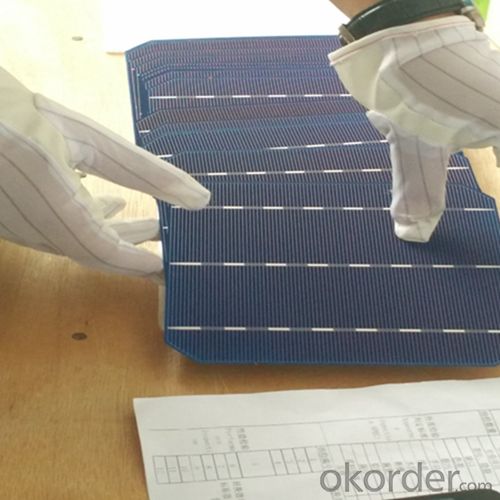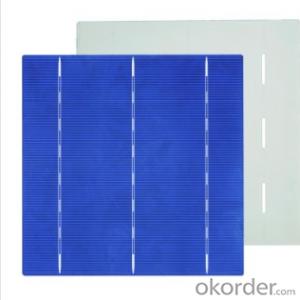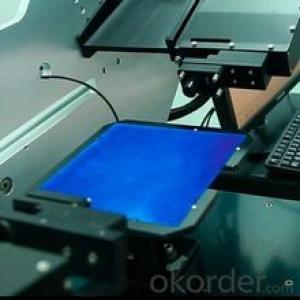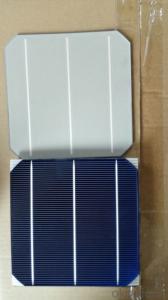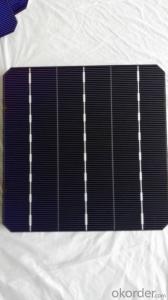Mono-Si Poly Solar Powered Cell Format 156mm x 156mm
- Loading Port:
- Shanghai
- Payment Terms:
- TT or LC
- Min Order Qty:
- 6500 watt
- Supply Capability:
- 6000000 watt/month
OKorder Service Pledge
OKorder Financial Service
You Might Also Like
The operation of a photovoltaic (PV) cell requires 3 basic attributes:
The absorption of light, generating either electron-hole pairs or excitons.
The separation of charge carriers of opposite types.
The separate extraction of those carriers to an external circuit.
In contrast, a solar thermal collector supplies heat by absorbing sunlight, for the purpose of either direct heating or indirect electrical power generation from heat. A "photoelectrolytic cell" (photoelectrochemical cell), on the other hand, refers either to a type of photovoltaic cell (like that developed by Edmond Becquerel and modern dye-sensitized solar cells), or to a device that splits water directly into hydrogen and oxygen using only solar illumination.Characteristic of Mono 156X156MM2 Solar Cells
You are gaining energy independence - add battery backup power for even greater energy security
The cost of electricity is only going to rise – insure against that rising cost
Adaptive cells change their absorption/reflection characteristics depending to respond to environmental conditions. An adaptive material responds to the intensity and angle of incident light. At the part of the cell where the light is most intense, the cell surface changes from reflective to adaptive, allowing the light to penetrate the cell. The other parts of the cell remain reflective increasing the retention of the absorbed light within the cell.[67]
In 2014 a system that combined an adaptive surface with a glass substrate that redirect the absorbed to a light absorber on the edges of the sheet. The system also included an array of fixed lenses/mirrors to concentrate light onto the adaptive surface. As the day continues, the concentrated light moves along the surface of the cell. That surface switches from reflective to adaptive when the light is most concentrated and back to reflective after the light moves along
Mechanical data and design
Format | 156mm x 156mm±0.5mm |
Thickness | 210μm±40μm |
Front(-) | 1.5mm bus bar (silver),blue anti-reflection coating (silicon nitride) |
Back (+) | 2.5mm wide soldering pads (sliver) back surface field (aluminium) |
Temperature Coefficient of Cells
Voc. Temp.coef.%/K | -0.35% |
Isc. Temp.coef .%/K | +0.024%/K |
Pm.Temp.coef. %/K | -0.47%/K |
Electrical Characteristic
Effiency(%) | Pmpp(W) | Umpp(V) | Impp(A) | Uoc(V) | Isc(A) | FF(%) |
18.35 | 4.384 | 0.526 | 8.333 | 0.63 | 8.877 | 78.39% |
18.20 | 4.349 | 0.526 | 8.263 | 0.63 | 8.789 | 78.54% |
18.05 | 4.313 | 0.525 | 8.216 | 0.63 | 8.741 | 78.32% |
17.90 | 4.277 | 0.524 | 8.161 | 0.625 | 8.713 | 78.04% |
17.75 | 4.241 | 0.523 | 8.116 | 0.625 | 8.678 | 77.70% |
17.60 | 4.206 | 0.521 | 8.073 | 0.625 | 8.657 | 77.36% |
17.45 | 4.170 | 0.519 | 8.039 | 0.625 | 8.633 | 76.92% |
17.30 | 4.134 | 0.517 | 8.004 | 0.625 | 8.622 | 76.59% |
17.15 | 4.096 | 0.516 | 7.938 | 0.625 | 8.537 | 76.80% |
17.00 | 4.062 | 0.512 | 7.933 | 0.625 | 8.531 | 76.18% |
16.75 | 4.002 | 0.511 | 7.828 | 0.625 | 8.499 | 75.34% |
16.50 | 3.940 | 0.510 | 7.731 | 0.625 | 8.484 | 74.36% |




 FAQ
FAQ
Q: What price for each watt?
A: It depends on the quantity, delivery date and payment terms, generally Large Quantity and Low Price
Q: What is your size for each module? Can you tell me the Parameter of your module?
A: We have different series of panels in different output, both c-Si and a-Si. Please take the specification sheet for your reference.
Q: What is your size for each module? Can you tell me the Parameter of your module?
A: We have different series of panels in different output, both c-Si and a-Si. Please take the specification sheet for your reference.
Solar Powered Cell Cleaning:
1. Should be based on the weather condition. In general, it should be washed much more often than in summer. Keep the panels clean can greatly improve the efficiency of solar power cell. If significant dust and snow can be seen by naked eye on the top of solar powered cell, it should be cleared up immediately.
2. Solar powered cell (Solar panel) converted the solar radiation into electrical energy through the photoelectric effect or photochemical effect directly or indirectly by absorbing sunlight, the main material for most solar powered cell, "silicon", but production the cost is so great that it cannot be a large number of widely and commonly used. Compared with ordinary batteries and rechargeable batteries, solar cells belong to more energy saving green products.
Precautions for Solar Powered Cell Installation:
1. Radiation should be adequate, good weather conditions are relatively stable, no hail snow.
In order to increase the energy output of the PV array, as far as possible to ensure that PV modules shine in the sun, shade avoidance between PV modules to each other, as well as other obstacles blocking the sun. Installation angle is also important.
2. Shall comply with the industrial project covers use planning requirements, and consistent with the air pollution control, water and nature conservation.
3. The site should avoid nature reserves, scenic spots, the source of drinking water and other sensitive target particular need of protection.
4. Conservation of land resources, makes full use of idle land, non-arable land or wasteland, and do not account for less fertile farmland.
5. Selection should provide enough space to meet the construction needs of production processes and auxiliary facilities.
6. Should have a good foundation of production conditions, water, electricity, transportation and other production factors abundant supply, energy supply reliable protection.
7. Flat terrain, easy to exclude rainwater and production, domestic wastewater.
8. Having sufficient protection distance from residential and environmental pollution should be sensitive points
- Q: How do solar cells perform in areas with high levels of bird droppings?
- Solar cells can experience a decrease in performance in areas with high levels of bird droppings. The droppings can block sunlight, reducing the amount of light reaching the solar cells and thereby diminishing their efficiency. Regular cleaning and maintenance can mitigate the impact of bird droppings on solar cell performance.
- Q: How big are solar cells?
- Solar cells vary in size depending on their application. They can range from small cells measuring a few centimeters in width and length, commonly used in portable electronics, to larger panels that can be several meters in width and length, used in residential or commercial installations.
- Q: What is the maximum efficiency possible for a solar cell?
- The maximum efficiency possible for a solar cell, also known as the Shockley-Queisser limit, is approximately 33.7%.
- Q: How do solar cells perform in tropical climates?
- Solar cells perform well in tropical climates due to the abundance of sunlight and high temperatures found in these regions. The intense sunlight allows solar cells to generate a higher amount of electricity, while the warmer temperatures can actually increase the efficiency of the cells. Additionally, solar panels are designed to withstand harsh weather conditions, including high humidity and heavy rain, commonly found in tropical climates.
- Q: Can solar cells be used to power parking meters?
- Yes, solar cells can be used to power parking meters. Solar cells convert sunlight into electricity, making them a sustainable and environmentally friendly power source for various applications, including parking meters. By harnessing solar energy, parking meters can operate independently, reducing the need for frequent battery replacements or connection to the electrical grid.
- Q: My son is very interested in solar cells recently, and keeps asking me about the structure of a solar cell. Can anybody help me answer that question?
- Here is what I found from my chemistry teacher: The basic component of a solar cell is pure silicon, which is not pure in its natural state.
- Q: Can solar cells be used in sports stadiums or arenas?
- Yes, solar cells can be used in sports stadiums or arenas. They can be installed on the roofs or other suitable areas to generate renewable energy that can be used to power various systems within the facility, such as lighting, scoreboards, or even charging stations for electric vehicles. Additionally, solar cells can help reduce the environmental impact of these large venues by decreasing their reliance on non-renewable energy sources.
- Q: Can solar cells be used for powering communication towers?
- Yes, solar cells can be used for powering communication towers. Solar panels or cells can generate electricity from sunlight, which can be converted and used to power various electronic devices and equipment, including communication towers. This renewable energy source is increasingly being adopted to reduce reliance on traditional power grids and decrease carbon emissions.
- Q: Can solar cells be installed on curved surfaces?
- Yes, solar cells can be installed on curved surfaces. Flexible solar panels are designed to be bendable and can conform to curved surfaces, making them suitable for a variety of applications such as solar-powered vehicles, curved rooftops, and even wearable technology.
- Q: Can solar cells be used in cold climates?
- Yes, solar cells can be used in cold climates. Although solar cells are more efficient in warmer temperatures, they can still generate electricity even in cold climates. Additionally, advancements in solar technology have made it possible for solar cells to work efficiently in low-light and snowy conditions.
Send your message to us
Mono-Si Poly Solar Powered Cell Format 156mm x 156mm
- Loading Port:
- Shanghai
- Payment Terms:
- TT or LC
- Min Order Qty:
- 6500 watt
- Supply Capability:
- 6000000 watt/month
OKorder Service Pledge
OKorder Financial Service
Similar products
Hot products
Hot Searches
Related keywords






